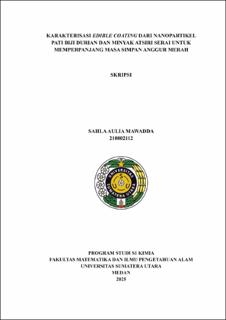Karakterisasi Edible Coating dari Nanopartikel Pati Biji Durian dan Minyak Atsiri Serai untuk Memperpanjang Masa Simpan Anggur Merah
Characterization of Edible Coating from Durian Seed Starch Nanoparticles and Lemongrass Essential Oil to Extending The Shelf Life Red Grapes

Date
2025Author
Mawadda, Sahla Aulia
Advisor(s)
Sinaga, Muhammad Zulham Efendi
Metadata
Show full item recordAbstract
This study analyzes the characteristics of edible coating based on durian seed starch nanoparticles added with lemongrass essential oil. The combination of durian seed starch nanoparticles with essential oil can be used as an innovation in coating red grapes to make them last longer because the cultivation of red grape plants is hampered by disease attacks by pathogenic microorganisms that can interfere with the quality of the harvest. This study aims to evaluate its effectiveness in extending the shelf life of red grapes using a quantitative method. Where starch nanoparticles are obtained using the starch hydrolysis method, then formulated with variations of lemongrass essential oil of 0%, 0.75%, 1%, 1.25%, and 1.5% with application to red grapes using the dipping method. The results of FTIR and PSA analysis of 232,8 nm indicate the success of starch modification into nanoparticles. The supporting characteristics of edible coating that are suitable for use as a coating for red wine are shown through antibacterial activity testing against E. coli and S. Aureus at EC/SR 1.0% producing a strong inhibition zone, supported by viscosity test results of 0.0588P which shows an optimal balance bepolisorbat physical performance and antibacterial effectiveness, making it the best choice for application on fresh products. Weight loss and WVTR tests produced good values, respectively 19.7% and 0.09797 kg s⁻¹ m⁻², so that edible coating is able to protect the product from water vapor entry. This is also proven by the test of vitamin C levels in red wine for 15 days of storage which is still maintained at a value of 13.65 mg/100 g. In addition, the results of the TPC test at the EC/SR variation of 1.0% showed a value of 5.82 × 10³ CFU/mL, so that the product is still considered suitable for consumption when compared to red wine without edible coating.
Collections
- Undergraduate Theses [1420]
